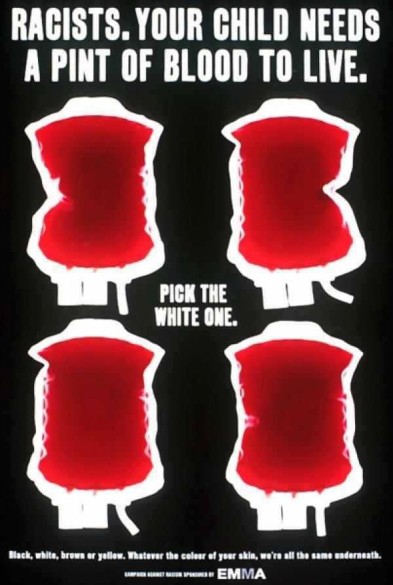Every now and then you’ll see something like this pop up on Facebook or other social media:
This is in the same vein as the “we all bleed red” line. The problem, of course, is that this doesn’t actually prove anything. You can’t tell what blood type any of them are either, but no one would argue that blood type doesn’t matter just because you can’t tell the difference from looking at the blood. For that matter, you can’t even tell if those are human blood or not, and yet if you tried to give a human a transfusion of animal blood, it would likely kill him. So the point this meme is trying to make simply doesn’t work. Further, not only does the meme fall flat, but the exact opposite is actually true. If you give those bags of blood to a computer, it could tell you which ones, if any, came from a European.
This is the subject of Nickolas Wade’s new book A Troublesome Inheritance: Genes, Race and Human History. Charles Murray at the WSJ reviewed the book:
The orthodoxy’s equivalent of the Nicene Creed has two scientific tenets. The first, promulgated by geneticist Richard Lewontin in “The Apportionment of Human Diversity” (1972), is that the races are so close to genetically identical that “racial classification is now seen to be of virtually no genetic or taxonomic significance.” The second, popularized by the late paleontologist Stephen Jay Gould, is that human evolution in everything but cosmetic differences stopped before humans left Africa, meaning that “human equality is a contingent fact of history,” as he put it in an essay of that title in 1984.
Since the sequencing of the human genome in 2003, what is known by geneticists has increasingly diverged from this orthodoxy, even as social scientists and the mainstream press have steadfastly ignored the new research. Nicholas Wade, for more than 20 years a highly regarded science writer at the New York Times, has written a book that pulls back the curtain. . . .
The title gives fair warning: “A Troublesome Inheritance: Genes, Race and Human History.” At the heart of the book, stated quietly but with command of the technical literature, is a bombshell. It is now known with a high level of scientific confidence that both tenets of the orthodoxy are wrong.
Mr. Lewontin turns out to have been mistaken on several counts, but the most obvious is this: If he had been right, then genetic variations among humans would not naturally sort people into races and ethnicities. But, as Mr. Wade reports, that’s exactly what happens. A computer given a random sampling of bits of DNA that are known to vary among humans—from among the millions of them—will cluster them into groups that correspond to the self-identified race or ethnicity of the subjects. This is not because the software assigns the computer that objective but because those are the clusters that provide the best statistical fit. If the subjects’ ancestors came from all over the inhabited world, the clusters that first emerge will identify the five major races: Asians, Caucasians, sub-Saharan Africans, Native Americans and the original inhabitants of Australia and Papua New Guinea. If the subjects all come from European ancestry, the clusters will instead correspond to Italians, Germans, French and the rest of Europe’s many ethnicities. Mr. Lewontin was not only wrong but spectacularly wrong. It appears that the most natural of all ways to classify humans genetically is by the racial and ethnic groups that humans have identified from time out of mind.
Ooops, well, there goes the “race is a social construct” idea. This is but the latest blow against racial egalitarian anti-science. They can shriek all they want about the “rise of scientific neoracism,” but our ever-expanding understanding of human genetics will simply continue to grind away at them. Expect the establishment’s racial dogma to take on a greater and greater religious tone as the scientific basis from their beliefs is systematically destroyed and they are forced to rely more and more heavily on faith and coercion to maintain the status quo.
Charles Murray is quick to note that it is inappropriate to speak of the “‘inferiority’ or ‘superiority’ of groups” in an absolute sense. This is completely in keeping with a biblical understanding of race. Since God made each race, they are what they are supposed to be (Matthew 25:14-30). We may certainly compare certain attributes and view certain attributes as more valuable than others, but this study and the Bible emphasize difference rather than a strict hierarchy.
Another point that must be made is that I disagree with Wade’s macroevolutionary viewpoint. But the fact that he extrapolates the current racial reality backwards to a false history doesn’t change the truth of that current racial reality – especially when there are creationist narratives which fit the current racial reality just as well.
Wade may consider the genetic realities and diversity of the nations and races of mankind to be “a troublesome inheritance,” but I consider it a blessing and gift which should be preserved.
| Tweet |
|
|
|






